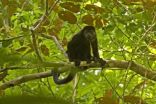(Press-News.org) ARLINGTON, Va.—The Office of Naval Research (ONR) is looking at birds' perceptual and maneuvering abilities as inspiration for small unmanned aerial vehicle (UAV) autonomy, and Popular Science is featuring this effort in its August issue, posted online July 25.
An ONR-funded, five-year Multidisciplinary University Research Initiative (MURI) program is examining the control and behavioral processes of birds and other small animals when flying at high speeds through complex environments, such as forests or urban settings. Researchers are trying to understand why birds make particular flight path choices and how they can do so quickly at higher speeds than would be safe for current engineered air systems in these environments.
The goal is to develop and successfully demonstrate a small aircraft that can navigate obstacles in very complex and unstructured surroundings, while maintaining speeds as fast as 5 meters per second. The theoretical results being developed may also be applicable to larger UAVs for particular tasks, such as landing at difficult, unprepared sites.
"Autonomous systems technology can be a great way to deliver increased capability to the Navy and Marine Corps at an affordable price," said Marc Steinberg, a research program officer in ONR's Science of Autonomy Program. "We can provide warfighters with a lot more flexibility and enable new mission performance, from flight under a forest canopy and in urban canyons to damage control applications onboard ships. Flying animals provide evidence it is possible to build compact platforms with limited sensing that can safely move through challenging environments."
In the lab, researchers set up an artificial forest with tall pipes serving as trees at Harvard University's Concord Field Station. Birds and a Massachusetts Institute of Technology (MIT)-built UAV are wired with small digital video cameras and motion-capture technology similar to that used in Hollywood. Both are studied in parallel to compare and learn from performance as the research progresses. A goal is to move to flight in a real forest by the program's end.
The idea is not to copy the birds but to incorporate lessons about how they navigate and use dynamic obstacle avoidance methods into a system that can make real-time decisions that take into account its surroundings. For example, researchers already have discovered a theoretical speed at which the probability of a collision is high in forests with an average distribution of trees; if a UAV stays below that threshold, the probability of an accident lowers dramatically. The program also has begun to reveal the types of flight strategies used by birds in these environments.
"We want to build small-scale UAVs that can fly quickly through indoor and/or cluttered environments, but controlling these UAVs is very different than controlling a fighter jet flying up above the clouds," said Dr. Russ Tedrake, X Consortium associate professor of electrical engineering and computer science and aeronautics and astronautics at MIT and the MURI lead. "To be successful, we have to solve a number of incredibly hard problems in computer vision and nonlinear control. This long-term project lets us focus on the basic research questions that will lead to fundamental results and, ultimately, dramatic new capabilities for UAVs."
In addition to providing warfighters greater flexibility, small UAVs are more agile and easily transportable, and they're less expensive. A program goal is to be able to do this type of flight with cheap, lightweight digital video cameras as the main sensors. This would eliminate the need for other sensors typically used, such as laser-based ones that add cost and weight, and the MURI is testing feasibility.
INFORMATION:
The MURI involves researchers and engineers from MIT, Harvard University, Carnegie Mellon University, New York University and Stanford University.
To view the full article in Popular Science, go to: http://www.popsci.com/technology/article/2012-07/how-teach-robot-improvise.
To see a video of the small UAVs in flight, go to: http://www.youtube.com/watch?v=voN9CCmzxYk.
A closely connected MURI with the University of Washington, Boston University, University of Maryland and University of North Carolina is examining similar issues with animals in the wild, including birds, bats and large insects such as hawk moths.
About the Office of Naval Research
The Department of the Navy's Office of Naval Research (ONR) provides the science and technology necessary to maintain the Navy and Marine Corps' technological advantage. Through its affiliates, ONR is a leader in science and technology with engagement in 50 states, 30 countries, 1,035 institutions of higher learning and more than 900 industry partners. ONR employs approximately 1,065 people, comprising uniformed, civilian and contract personnel, with additional employees at the Naval Research Lab in Washington, D.C.
ONR-funded research takes flight in Popular Science article
Researchers examining birds' control and behavioral processes as a model for small, highly maneuverable aircraft
2012-07-26
ELSE PRESS RELEASES FROM THIS DATE:
Study links alcohol/energy drink mixes with casual, risky sex
2012-07-26
BUFFALO, N.Y. -- A new study from the University at Buffalo's Research Institute on Addictions (RIA) has found a link between the consumption of caffeinated energy drinks mixed with alcohol and casual -- often risky -- sex among college-age adults.
According to the study's findings, college students who consumed alcohol mixed with energy drinks (AmEDs) were more likely to report having a casual partner and/or being intoxicated during their most recent sexual encounter.
The results seem to indicate that AmEDs may play a role in the "hook-up culture" that exists on ...
Mind vs. body? Dualist beliefs linked with less concern for healthy behaviors
2012-07-26
Many people, whether they know it or not, are philosophical dualists. That is, they believe that the brain and the mind are two separate entities. Despite the fact dualist beliefs are found in virtually all human cultures, surprisingly little is known about the impact of these beliefs on how we think and behave in everyday life.
But a new research article forthcoming in Psychological Science, a journal of the Association for Psychological Science, suggests that espousing a dualist philosophy can have important real-life consequences.
Across five related studies, researchers ...
Public strongly supports programs helping farmers adapt to climate change
2012-07-26
EAST LANSING, Mich. — A survey conducted by Michigan State University reveals strong public support for government programs to assist farmers to adapt to climate change.
According to NASA research, global temperatures have been rising for decades, and it's affecting all aspects of agriculture. Regardless of what those surveyed believe causes climate change, more than 65 percent of them support government assistance for farmers, said Scott Loveridge, MSU professor of agricultural, food and resource economics.
This year has been a particularly harsh example. This summer's ...
NASA and university researchers find a clue to how life turned left
2012-07-26
GREENBELT, Md. -- Researchers analyzing meteorite fragments that fell on a frozen lake in Canada have developed an explanation for the origin of life's handedness – why living things only use molecules with specific orientations. The work also gave the strongest evidence to date that liquid water inside an asteroid leads to a strong preference of left-handed over right-handed forms of some common protein amino acids in meteorites. The result makes the search for extraterrestrial life more challenging.
"Our analysis of the amino acids in meteorite fragments from Tagish ...
Women with diabetes more likely to experience sexual dissatisfaction
2012-07-26
Women with diabetes are just as likely to be interested in, and engage in, sexual activity as non-diabetic women, but they are much more likely to report low overall sexual satisfaction, according to a UCSF study.
The researchers also found that diabetic women receiving insulin treatment were at higher risk for the specific complications of lubrication and orgasm.
"Diabetes is a recognized risk factor for erectile dysfunction in men, but there have been almost no data to indicate whether it also affects sexual function in women," said senior author Alison J. Huang, ...
How the fluid between cells affects tumors
2012-07-26
July 25, 2012
There are many factors that affect tumor invasion, the process where a tumor grows beyond the tissue where it first developed. While factors like genetics, tissue type and environmental exposure affect tumor metastasis and invasion, physical forces like fluid flow remain a poorly understood component of tumor invasion. A new video article in JoVE, the Journal of Visualized Experiments, describes a novel procedure that allows researchers to study and test the microenvironment of a growing tumor. The technique is valuable because it allows scientists to assay ...
Piglets in mazes provide insights into human cognitive development
2012-07-26
URBANA -- Events that take place early in life almost certainly have consequences for later cognitive development. Establishing the connections is difficult, however, because human infants cannot be used as laboratory subjects.
Rodney Johnson and his collaborators have developed an alternative model for studying infant brain development. "Assistant professor Ryan Dilger and I became interested in establishing the neonatal piglet as a model of human brain and cognitive development 3 or 4 years ago," he said.
The idea came to Johnson when a former student, who was working ...
Texas A&M biologists prove ZOLOFT packs potential to fight fungal meningitis
2012-07-26
New research conducted by biologists at Texas A&M University suggests that ZOLOFT®, one of the most widely prescribed antidepressants in the world, also packs a potential preventative bonus — potent mechanisms capable of inhibiting deadly fungal infections.
The findings are the result of a two-year investigation by Xiaorong Lin, assistant professor of biology, and Matthew S. Sachs, professor of biology, involving sertraline hydrocholoride (ZOLOFT) and its effects on Cryptococcus neoformans, the major causative agent of fungal meningitis — specifically, cryptococcal meningitis, ...
Increasing dopamine in brain's frontal cortex decreases impulsive tendency, UCSF-Gallo study finds
2012-07-26
Raising levels of the neurotransmitter dopamine in the frontal cortex of the brain significantly decreased impulsivity in healthy adults, in a study conducted by researchers at the Ernest Gallo Clinic and Research Center at the University of California, San Francisco.
"Impulsivity is a risk factor for addiction to many substances, and it has been suggested that people with lower dopamine levels in the frontal cortex tend to be more impulsive," said lead author Andrew Kayser, PhD, an investigator at Gallo and an assistant professor of neurology at UCSF. "We wanted to ...
Tropical arks reach tipping point
2012-07-26
Almost half of the tropical forest reserves in a new study are ineffective, according to results published in the journal Nature by William Laurance, research associate at the Smithsonian Tropical Research Institute now at James Cook University in Australia and more than 200 co-authors.
"Biodiversity is declining rapidly at reserves including Kahuzi Biega in the Democratic Republic of Congo, Xishuangbanna in southern China, and Northern Sierra Madre in the Philippines, among others," said Laurance. "Reserves that are doing relatively well include Bwindi Impenetrable N.P. ...
LAST 30 PRESS RELEASES:
Interaction of climate change and human activity and its impact on plant diversity in Qinghai-Tibet plateau
From addressing uncertainty to national strategy: an interpretation of Professor Lim Siong Guan’s views
Clinical trials on AI language model use in digestive healthcare
Scientists improve robotic visual–inertial trajectory localization accuracy using cross-modal interaction and selection techniques
Correlation between cancer cachexia and immune-related adverse events in HCC
Human adipose tissue: a new source for functional organoids
Metro lines double as freight highways during off-peak hours, Beijing study shows
Biomedical functions and applications of nanomaterials in tumor diagnosis and treatment: perspectives from ophthalmic oncology
3D imaging unveils how passivation improves perovskite solar cell performance
Enriching framework Al sites in 8-membered rings of Cu-SSZ-39 zeolite to enhance low-temperature ammonia selective catalytic reduction performance
AI-powered RNA drug development: a new frontier in therapeutics
Decoupling the HOR enhancement on PtRu: Dynamically matching interfacial water to reaction coordinates
Sulfur isn’t poisonous when it synergistically acts with phosphine in olefins hydroformylation
URI researchers uncover molecular mechanisms behind speciation in corals
Chitin based carbon aerogel offers a cleaner way to store thermal energy
Tracing hidden sources of nitrate pollution in rapidly changing rural urban landscapes
Viruses on plastic pollution may quietly accelerate the spread of antibiotic resistance
Three UH Rainbow Babies & Children’s faculty elected to prestigious American Pediatric Society
Tunnel resilience models unveiled to aid post-earthquake recovery
Satellite communication systems: the future of 5G/6G connectivity
Space computing power networks: a new frontier for satellite technologies
Experiments advance potential of protein that makes hydrogen sulfide as a therapeutic target for Alzheimer’s disease
Examining private equity’s role in fertility care
Current Molecular Pharmacology achieves a landmark: real-time CiteScore advances to 7.2
Skeletal muscle epigenetic clocks developed using postmortem tissue from an Asian population
Estimating unemployment rates with social media data
Climate policies can backfire by eroding “green” values, study finds
Too much screen time too soon? A*STAR study links infant screen exposure to brain changes and teen anxiety
Global psychiatry mourns Professor Dan Stein, visionary who transformed mental health science across Africa and beyond
KIST develops eco-friendly palladium recovery technology to safeguard resource security
[Press-News.org] ONR-funded research takes flight in Popular Science articleResearchers examining birds' control and behavioral processes as a model for small, highly maneuverable aircraft



